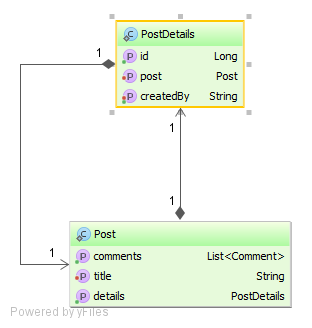A beginner’s guide to read and write skew phenomena
Introduction
In my article about ACID and database transactions, I introduced the three phenomena described by the SQL standard:
- dirty read
- non-repeatable read
- phantom read
While these are good to differentiate the four isolation levels (Read Uncommitted, Read Committed, Repeatable Read and Serializable), in reality, there are more phenomena to take into consideration as well. The 1995 paper (A Critique of ANSI SQL Isolation Levels) introduces the other phenomena that are omitted from the standard specification.
In my High-Performance Java Persistence book, I decided to insist on the Transaction chapter as it is very important for both data access effectiveness and efficiency.
Domain model
For the following examples, I’m going to use the following two entities:
In our fictional application, when the Post title is changed, the author must be recorded in the associated PostDetails record. If read and write skew are not prevented, this domain model constraint can be compromised, as you will see in the following test cases.
Read skew
The following test simulates how a read skew can happen:
doInConnection(aliceConnection -> {
prepareConnection(aliceConnection);
String title = selectStringColumn(
aliceConnection,
selectPostTitleSql()
);
executeSync(() -> {
doInConnection(bobConnection -> {
prepareConnection(bobConnection);
try {
update(
bobConnection,
updatePostTitleParamSql(),
new Object[]{"Bob"}
);
update(
bobConnection,
updatePostDetailsAuthorParamSql(),
new Object[]{"Bob"}
);
} catch (Exception e) {
LOGGER.info("Exception thrown", e);
preventedByLocking.set(true);
}
});
});
String createdBy = selectStringColumn(
aliceConnection,
selectPostDetailsAuthorSql()
);
});
- Alice selects a Post title
- Bob sneaks in and updates the Post and the PostDetails entities
- Alice thread is resumed and she selects the PostDetails record
If read skew is permitted, Alice sees Bob’s update and she can assume that the previous Post version (that she read at the beginning of her transaction) was issued by Bob (which might not be accurate).
Running this test on the four most common relation database systems gives the following results:
| Database isolation level | Read skew |
|---|---|
| Oracle Read Committed | Yes |
| Oracle Serializable | No |
| SQL Server Read Uncommitted | Yes |
| SQL Server Read Committed | Yes |
| SQL Server Read Committed Snapshot Isolation | Yes |
| SQL Server Repeatable Read | No |
| SQL Server Serializable | No |
| SQL Server Snapshot Isolation | No |
| PostgreSQL Read Uncommitted | Yes |
| PostgreSQL Read Committed | Yes |
| PostgreSQL Repeatable Read | No |
| PostgreSQL Serializable | No |
| MySQL Read Uncommitted | Yes |
| MySQL Read Committed | Yes |
| MySQL Repeatable Read | No |
| MySQL Serializable | No |
Write skew
To emulate write skew, you need to execute the following test case:
doInConnection(aliceConnection -> {
prepareConnection(aliceConnection);
String title = selectStringColumn(
aliceConnection,
selectPostTitleSql()
);
String createdBy = selectStringColumn(
aliceConnection,
selectPostDetailsAuthorSql()
);
executeSync(() -> {
doInConnection(bobConnection -> {
prepareConnection(bobConnection);
try {
String bobTitle = selectStringColumn(
bobConnection,
selectPostTitleSql()
);
String bonCreatedBy = selectStringColumn(
bobConnection,
selectPostDetailsAuthorSql()
);
update(
bobConnection,
updatePostTitleParamSql(),
new Object[]{"Bob"}
);
} catch (Exception e) {
LOGGER.info("Exception thrown", e);
preventedByLocking.set(true);
}
});
});
update(
aliceConnection,
updatePostDetailsAuthorParamSql(),
new Object[]{"Alice"}
);
});
- Alice selects the Post title and the author from the PostDetails record
- Bob also selects the Post title and the associated author, but he decides to update the title only
- Alice thinks of updating the PostDetails record without changing the Post title
If write skew is permitted, Alice and Bob disjoint writes will be executed without being blocked by the constraint that governs both records.
Running this test on the four most common relation database systems gives the following results:
| Database isolation level | Write skew |
|---|---|
| Oracle Read Committed | Yes |
| Oracle Serializable | Yes |
| SQL Server Read Uncommitted | Yes |
| SQL Server Read Committed | Yes |
| SQL Server Read Committed Snapshot Isolation | Yes |
| SQL Server Repeatable Read | No |
| SQL Server Serializable | No |
| SQL Server Snapshot Isolation | Yes |
| PostgreSQL Read Uncommitted | Yes |
| PostgreSQL Read Committed | Yes |
| PostgreSQL Repeatable Read | Yes |
| PostgreSQL Serializable | No |
| MySQL Read Uncommitted | Yes |
| MySQL Read Committed | Yes |
| MySQL Repeatable Read | Yes |
| MySQL Serializable | No |
- Write skew is prevalent among Multi-Version Concurrency Control mechanisms and Oracle cannot prevent it even when claiming to be using Serializable, which in fact is just a Snapshot Isolation level instead.
- SQL Server default locking-based isolation levels can prevent write skews when using Repeatable Read and Serializable. Neither one of the snapshot isolation levels (MVCC-based) can prevent/detect it instead.
- PostgreSQL prevents it using its more advanced Serializable Snapshot Isolation level
- MySQL employs shared locks when using Serializable, so the write skew can be prevented even if InnoDB is also MVCC-based
If you are interested in this topic, then you might as well enjoy my High-Performance Java Persistence book that I’m writing.
| Reference: | A beginner’s guide to read and write skew phenomena from our JCG partner Vlad Mihalcea at the Vlad Mihalcea’s Blog blog. |





